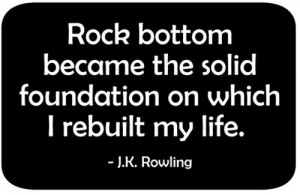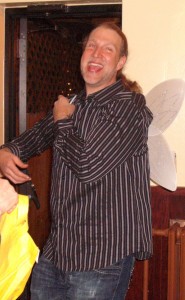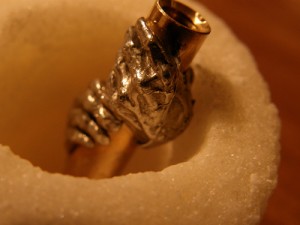Step 1 – Admitted we were powerless over our art and our creative lives had become unmanageable.
 The first step in a 12-step program has ZERO solution in it. The first step is about being so shattered, so broken, so sick and tired of being sick and tired, that I will do anything to change. Anything at all.
The first step in a 12-step program has ZERO solution in it. The first step is about being so shattered, so broken, so sick and tired of being sick and tired, that I will do anything to change. Anything at all.
It’s like the story of the pacifist who was also a prince. As a prince, he was required to carry a sword as a sign of his station, but he was also a pacifist and believed strongly in non-violence.
So torn, so filled with conflict, he went to a church elder and told the elder about his situation. How do I carry a sword and be a pacifist at the same time?
The elder said, “Carry the sword until it is too heavy to carry.”
The first step is about realizing that the goddamn sword is so heavy it’s breaking our goddamn backs.
And of course, as everyone knows, the first step is about the bottom. The depths of despair. Hopelessness.
 My bottom came six years ago when I attended my very first writers’ workshop, in Big Sur, California. It started out heroic. I was Achilles, sword, shield, even a printer because my wife and I just knew that the agent would want me to print out a copy right then and there. Still, even though I was armed for success, I was terrified. I was shaking. My eyes were bunny rabbit-wide open.
My bottom came six years ago when I attended my very first writers’ workshop, in Big Sur, California. It started out heroic. I was Achilles, sword, shield, even a printer because my wife and I just knew that the agent would want me to print out a copy right then and there. Still, even though I was armed for success, I was terrified. I was shaking. My eyes were bunny rabbit-wide open.
I sat down in front of the agent, and she knew I was about to implode, because she asked me, “Are you all right?” She moved a little toward the door.
I said, “Yeah, sure, go on.” Inside, I was approaching the guillotine.
And then she hit me with every inch of a beating stick. Because I was an amateur. Because what I had was rough. Because I thought I could write in isolation, without help, without guidance, and if I couldn’t do it on my own, I didn’t want to succeed.
At one point, she leaned back, winced, pointed to my pages and said, “Where are you going with all this?”
I tried to fumble around to explain the characters, the stories, the things I so loved about my book. But of course, it was too late. I was reduced to ashes. It broke me. My worst fears had come true.
I had hit bottom. I couldn’t walk this writers’ journey alone.
I used to say that first rejection was when my writing dreams were destroyed. That’s not really what happened. What happened was my fantasies were destroyed. The fantasies of an overnight success, where I went from obscurity to fame and fortune because of my innate genius.
 That fantasy died with that agent. The dream continues. Because the dream is that I can write and enjoy it. I can move people and give my voice to the world of literature and art because I have a unique voice. That is the dream. And when I’m writing, working, creating, marketing, overcoming fears, I am living that dream. Will I ever be a bestselling, jet-owning, fun-loving author loved by billions? I don’t know. That’s the fantasy, and some people get to live that. For me, the dream has to be what I do every day, right now.
That fantasy died with that agent. The dream continues. Because the dream is that I can write and enjoy it. I can move people and give my voice to the world of literature and art because I have a unique voice. That is the dream. And when I’m writing, working, creating, marketing, overcoming fears, I am living that dream. Will I ever be a bestselling, jet-owning, fun-loving author loved by billions? I don’t know. That’s the fantasy, and some people get to live that. For me, the dream has to be what I do every day, right now.
In the words of that Canadian power-trio rock band, and I don’t mean Triumph, “Some are born to rule the world to live their fantasies. But most of us just dream about the things we’d like to be…”
That’s Neil Peart from Rush. And those words are true.
Hitting bottom can be dramatic, like what happened to me, like what happened to Sid Vicious, and to other hardcore addicts and alcoholics, but not necessarily so.
A little piece of 12-step program; you hit bottom when you stop digging, turn around and start climbing out of the hole you’ve dug.
A bottom is a turning point, where you realize you have a problem and seek help. And it might be getting locked up for not writing and sitting in San Quentin with tattooed murderers.
“Whatcha’ in for?”
“I killed and ate my family. What’re you in for?”
“I couldn’t write. Snapped. Burned all my manuscripts.”
“Damn. Book burner. Hardcore.”
Or it might be a Tuesday, and you are in bed, and you realize, “Another day I didn’t write. Why can’t I find the time? What is wrong with me?”
The only important thing about a bottom is that you change. That’s the critical part.

